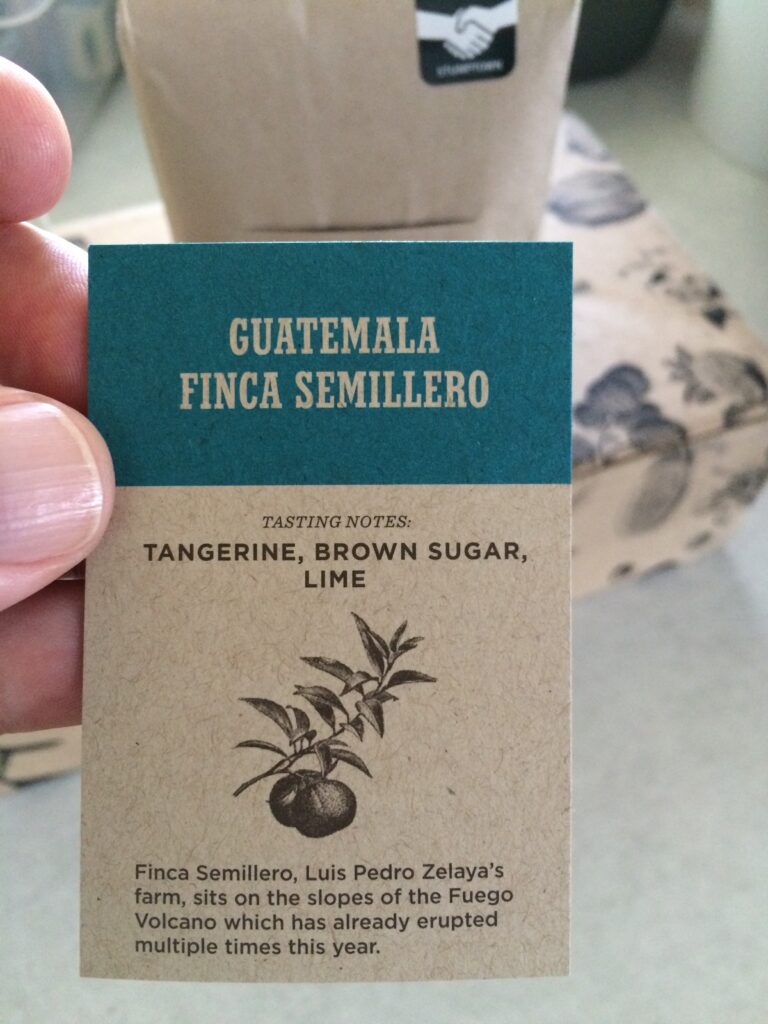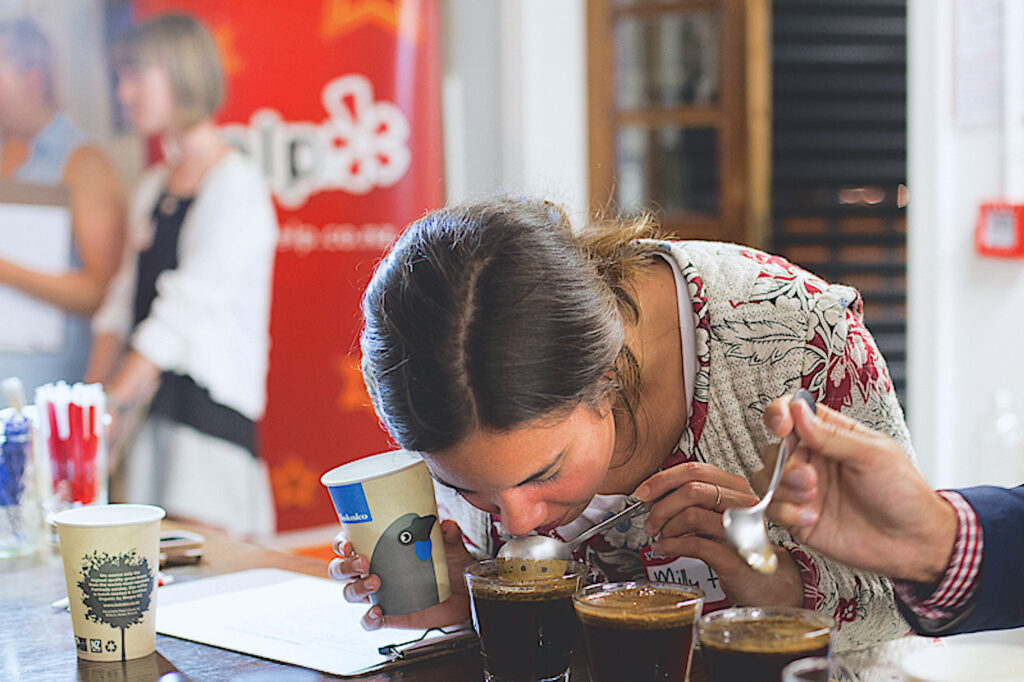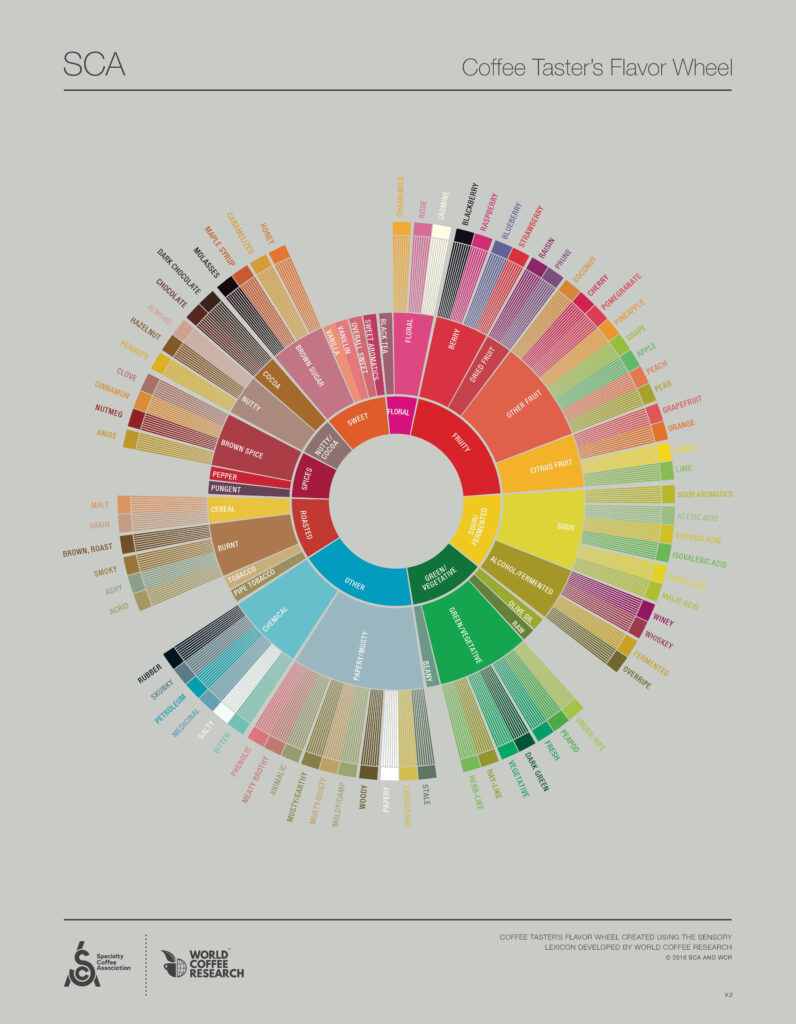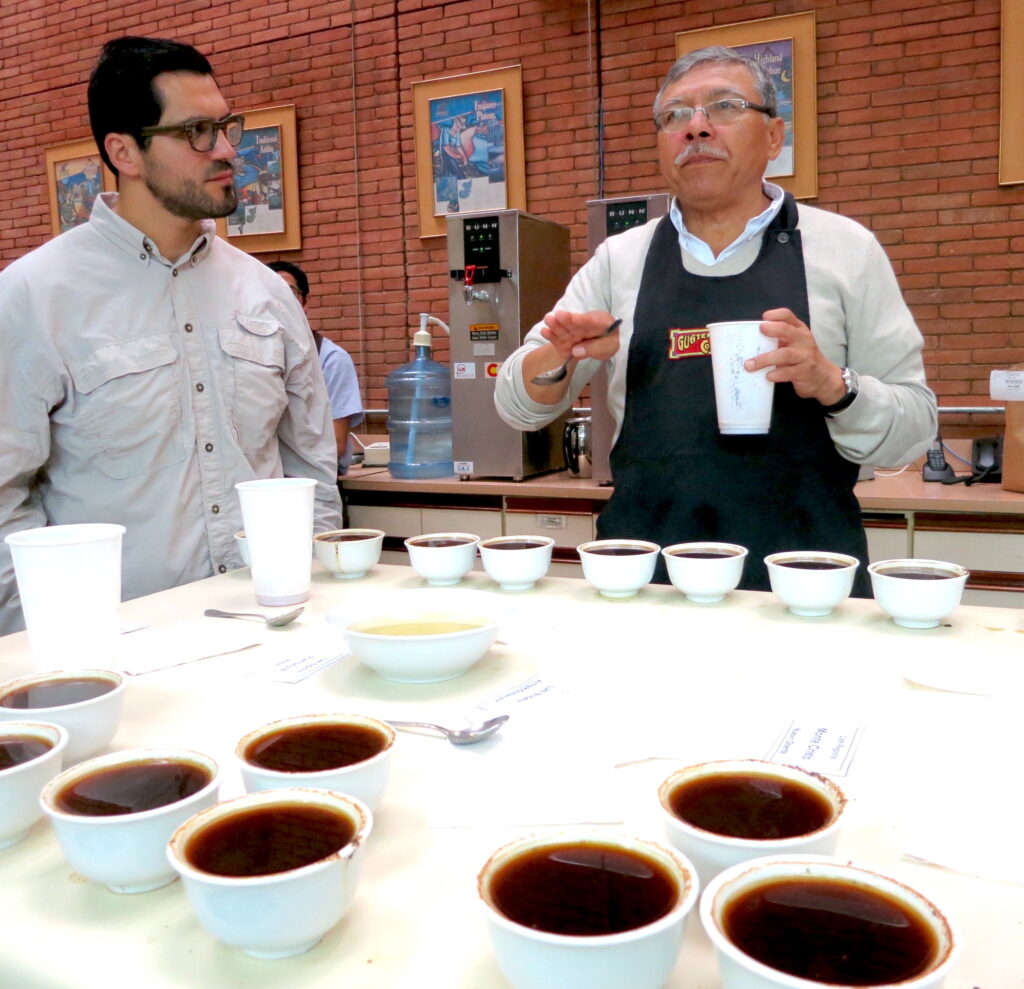When Coffee Is Like Angel Cake With Strawberry Jam
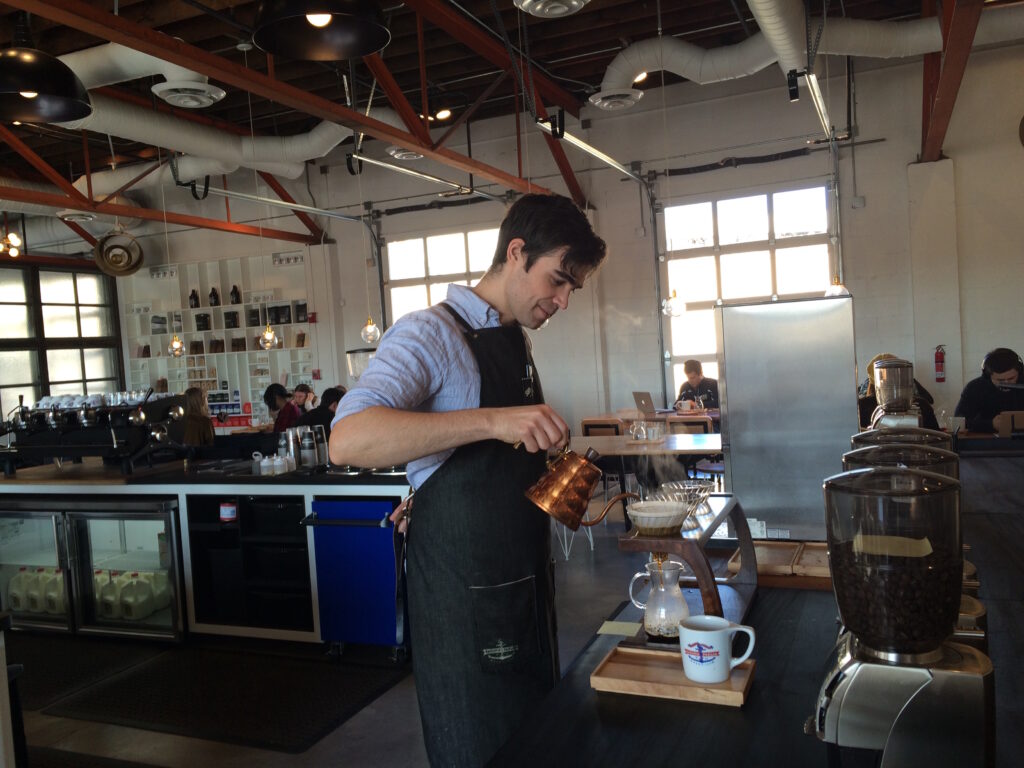
Excerpted from Making Better Coffee: How Maya Farmers and Third Wave Tastemakers Create Value. University of California Press, 2022. All rights reserved.
One Saturday morning in mid-January 2020, Elika Liftee was getting ready to make a special cup of coffee. He was backstage behind a row of blue, trade-show curtains that had transformed a former factory in Nashville, Tennessee, into the site of a qualifying round for the United States Coffee Championship. Conversations were hushed as the more than 40 competitors consulted with their teams and rehearsed presentations. On the other side of the divide, audience members found their seats while technicians double-checked the equipment. The winners of this qualifying event would advance to the national championships.
Born in Japan to an Air Force mother and a Hawaiian father, Liftee grew up in Oklahoma—a typical Midwestern childhood, as he describes it, but with a kitchen stocked full of papaya, guava, and other tropical foods. He attended college for a few semesters, then worked several odd jobs before finally landing a position at Onyx Coffee Lab in Rogers, Arkansas. In a progression characteristic of many coffee professionals, he first visited Onyx as a customer—he was a regular in his college days—and when they brought him on as an employee, he started as a barista and moved up through the ranks before becoming a trainer. He tells me that in his early days at Onyx, his interest in coffee became an obsession: After soaking up as much as he could on the job, he would go home and watch YouTube videos and read research reports from the UC Davis Coffee Center.
The Nashville event was Liftee’s third attempt at the U.S. Brewer’s Cup competition. Preparing, he explains, always starts with a story, and this time he decided to tell his own story. For the coffee, he chose a naturally processed Gesha—a prized varietal of the Coffea arabica species—grown on the La Palma y El Tucán farm in Colombia. Onyx paid a hefty US$212 a pound for the specialty beans at a time when average commodity coffee, by contrast, was trading for US$1.04 per pound on the New York exchange. But Liftee was enchanted by its range of flavors, from pineapple nectar and stewed strawberries to plum and black tea. Natural processing, in which the fruit is allowed to partially rot off the beans, imparts a fruity acidity, and Liftee wanted to use those notes to reflect his heritage.
Brewer’s Cup contestants train for months, sometimes years, to prepare, investing time and money to hire coaches, search out obscure coffees with unusual tastes, and practice their skills. With detailed protocols covering everything from water quality to grinder specifications, this is no casual contest. Entrants each have 10 minutes to brew and present their coffee to a panel of three judges. The coffee will be tasted at three temperatures—70 degrees Celsius, 40 degrees Celsius, and 30 degrees Celsius—and rated on a scale from zero to 10 in seven areas (aroma, flavor, aftertaste, acidity, body, balance, and overall taste). Points are added up, along with an evaluation of service and presentation, to produce an overall numerical score. Taste may seem particularly subjective, but the judges have been trained in sensory evaluation techniques, and there is surprisingly little variation in scores.
The organizers go to great lengths to make these competitions as objective as possible. But a lot still rests on the hard-to-quantify art of storytelling—the narrative brewers tell to situate their coffees and justify their choices.
When he takes the stage, Liftee tells the story of La Palma y El Tucán. While he heats the water and grinds the beans, he talks about the couple who run the farm and their dedication to cultivating unusual varietals. As he pours hot water over 10 grams of ground coffee nestled in Kalita Wave drippers, Liftee explains his quick pour technique (two minutes rather than the usual four) and the ways flavors evocative of Hawaii and Japan emerge as the coffee cools.
With individual cups presented to them, the judges pull out their tasting spoons, dip into the brew, and slurp loudly, rolling the liquid around in their mouths before spitting it out and contemplating their scores. In the final tally, Liftee earns 162.83 out of a possible 200 points and claims the top spot. He went on to win the national championships the following month with the same coffee and presentation.
From an anthropological perspective, such competitions can tell us a lot about underlying cultural values and power dynamics.
When I first started exploring the world of high-end (or Third Wave) coffees, it felt at once familiar and exotic. I considered myself a pretty serious coffee drinker, spent a lot of time in coffee shops, and was conversant with trends in artisanal foodstuffs. Still, I felt like an interloper at competitions and trade shows, out of my league among all the professionals and aficionados committed to the craft and science of coffee, with their own specialized language, customs, and opaque points of reference.
Over time, I came to see how the high-end coffee world, as a cultural community, orients itself around certain values that transcend the beverage itself: a dedication to craft, a quest for quality, a veneration of authenticity, and a commitment to building social relationships through the commercial trade. There is certainly competition and discord, bad actors and better ones, and contradictions between ideals and practice, but the most frequent refrain in my many conversations with coffee professionals was around the common project of finding and producing better coffee—better tasting and better for the farmers who grow it.
But this raises a number of questions: What makes a coffee “better”? What goes into a coffee like the La Palma y El Tucán Gesha to make it worth US$212 a pound? How can we measure a sensory experience down to two decimal points? At a coffee shop, customers are asked to pay more for quality, but who decides what constitutes “quality”? For most customers, high-end coffee selection is akin to looking at a restaurant’s list of unfamiliar wines: A higher price indicates better quality, rather than the other way around.
Coffee merchants, roasters, and tastemakers talk about “discovering” quality, as if it were independently out there in the world. The specialty coffee industry has built up elaborate scientific protocols to ground their definitions of quality in empirical terms, creating new metrics, standards, and lexicons for taste. Not coincidentally, the language used to talk about high-end coffee borrows heavily from fine wine by invoking ideas of craft production and terroir, a French term for the growing conditions of soil, rainfall, altitude, and other elements that affect taste and smell.
There are certainly noticeable, objective differences in flavor between high-end coffees and a typical cup of joe, some of them stark, that can be traced to the combinations of a multitude of chemical compounds. But what those taste differences mean is learned, and what is considered quality has changed over time.
Until recently, coffee taste-testing—or “cupping”—descriptors were mostly limited to broad attributes, such as “bold,” “balanced,” “bitter,” or perhaps “elegant.” With the rise of specialty coffees, and the formation of the Specialty Coffee Association (SCA), cupping was transformed from a quirky talent into a formal skill, grounded in scientific replicability, that could be taught. Ted Lingle, a pioneer in this area, integrated chemistry and sensory science into new cupping protocols designed, as he put it, “to make as objective an evaluation of the coffee’s quality attributes as humanly possible.”
Lingle’s protocols provide the basis for the SCA’s 100-point scale, which is built from rating 10 quality attributes: “fragrance/aroma, flavor, aftertaste, acidity, body, balance, uniformity, clean cup, sweetness, and overall.” The first five are based on the physical chemistry of coffee while the last five are grounded in sensory perceptions; the “overall” attribute allows for a cupper’s more subjective appraisal. While there are a few different cupping protocols, the SCA’s 100-point scale is the industry standard.
Similarly, in the wine world, sensory descriptions were revolutionized in the 1980s by the adoption of wine researcher Ann C. Noble’s “aroma wheel,” establishing a common vocabulary. Based on that example, the SCA worked with researchers at the University of California, Davis, and Kansas State University to develop the Coffee Taster’s Flavor Wheel. Ranging from Chamomile, Rose, and Jasmine to Petroleum, Skunk, and Pipe Tobacco, the flavor wheel is a remarkable study in the art and science of taste: trying to classify and categorize an ultimately subjective sensory experience, mixing poetry and botany.
Based on the SCA protocols, the Coffee Quality Institute developed and administers the Q Grader certification program. Being certified as a Q Grader is a badge of honor in the Third Wave coffee world. It often takes years to pass the various tests of knowledge and skill, and some aspirants hire a coach to help them train. Successful applicants have to pass five “triangulation cuppings” to differentiate more than 90 coffees as well as complete other tests, such as identifying the addition of a specific acid (acidic, citric, malic, lactic, or phenol) to identical cups of coffee. It is a grueling and rigorous process, converting subjective impressions into replicable objective measures.
Even with a common vocabulary, there can be idiosyncratic differences and variability in judging intensity. In order to calibrate the flavor wheel categories on a 0–15 scale of intensity, World Coffee Research published the first-ever Sensory Lexicon for coffee in 2016. The lexicon provides a categorization of tastes that is descriptive, quantifiable, and, for those trained in its use, replicable: Two trained tasters anywhere in the world should give the same score for any attribute based on a standard protocol.
Still, many coffee cuppers say that, in practice, they use the flavor wheel as a reference to help think about flavors, but not as a strict categorization framework. Many will work by first identifying a broad flavor (perhaps something malty). Then they will systematically think through specific examples, comparing them with a recent sensory memory: beer (no), malted milk (no), these are too malty … something more subtle … gingerbread, perhaps.
When it comes down to it, cupping is an art of improvisational practice. One must creatively engage an existing framework in a way that others can understand and invoke among as many people as possible sensory connotations.
The value placed on certain flavors is always changing, especially in the high-end market where the richest rewards come from selling something singular, unusual, and unique. Not that long ago, the fruity and floral flavors Liftee was highlighting in his winning presentation were considered defects, aberrations from the nutty, chocolatey flavors typically associated with the taste of coffee. Now, the fruity, “juicy” acidity of natural processed coffees is highly valued; I heard one coffee described recently as like “angel cake with strawberry jam.”
Through conversations and competitions, coffee professionals and enthusiasts work out among themselves conventional understandings about which traits should be valued and which should be discounted, the flavors that are in and those that are out, what commands a price premium this season and what does not. Often, these value judgments tap into a bourgeoisie consumer pursuit of excellence and authenticity. This is a trend toward differentiation, with marketing narratives emphasizing distinctions between geographic origins, subtle flavor profiles, and relations with producers. Such stories give unique context and meaning to what might otherwise be just another undifferentiated mass commodity.
In this system, the real power derives from the ability to define what quality is—and not everyone has access to this power.
This excerpt has been edited for style, length, and clarity.
































